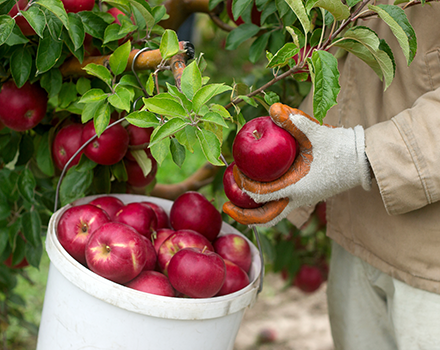Introduction
A popular tendency in fruit and vegetable farming is to pay workers piece-rate, which while complying with minimum wage laws, can be used to pay workers in lieu of the traditional $/hour wage system.
What is piece-rate?
Piece-rate, or piecemeal pay, means that employees are paid by the unit when completing a particular task, for instance, bushels harvested, trees pruned, or acres mowed.
In this case, a worker is compensated by individual output and not by an hourly rate. Below we will outline some formulas and procedures for calculating piece rate payouts in compliance with minimum wage and overtime laws.

Complying with Minimum Wage
When paying piecemeal, employers must be sure to always comply with minimum wage laws in their area: workers may not be paid less than minimum wage after calculation of the equivalent per-hour pay.
Calculating Piece Payout:
To comply with the minimum wage requirement, an employer is required to make some region-specific calculations.
1. First, the employer must track the total number of hours worked.
2. Then, the employer must divide the worker’s piece-rate wage by the total number of hours worked.
3. This will give a hypothetical per-hour wage, which will have to be compared to the minimum wage. A piece-rate payout must not be less than the legal minimum wage in the area.
Example Calculation:
A worker makes $480 over the course of a 40 hour work-week. The calculation just described ($480/40hours) comes out to a $12 per hour wage. In an area where this is equal to or exceeding the minimum wage, an employer can pay out the employee the $480 as usual, and stop there.
Say, however, that this particular job took place in Seattle, Washington, where the minimum wage is $15 per hour. The legal obligation of employers to pay a piece-rate wage which does not go below minimum wage would not be satisfied ($15 wage X 40 hours = $600). In this case, the employer must pay the $120 difference, on top of the piece-rate compensation.
A calculation such as this one must be used in each project a worker completes, to make sure that the particular project and the ensuing piece-rate compensation is not, in the final analysis, below minimum wage.
Complying with Overtime
Even when paying piece rate, an employer must always track the number of hours their employees work. Once an employee works over 40 hours in a single week, they must be awarded overtime pay. Always be aware of the overtime regulations in your area when calculating your payroll - some regions, such as California in the United States, have their own requirements for minimum wage and overtime.
Calculating Overtime Piece-Rate:
1. First, the employer must calculate the worker’s average hourly wage throughout the week, including overtime.
2. Next, the rate of overtime pay comes from multiplying overtime hours by 1.5 times the base compensation.
Example Calculation:
An employee works 50 hours in a week at $15 an hour. At their normal rate, this would result in a total of $750 in piece-rate compensation. However, because a work-week maximum would be 40 hours, there would be 10 hours of overtime, and only the first 40 hours can be paid at the standard rate.
Instead, the employee's regular hours would be calculated first, at $15/hour. 40 x $15 = $600 of pay for regular hours.
In this case, the overtime pay would have to be calculated on top of the standard payout:
$15 (base pay) x 1 .5 (overtime rate) X 10 hours of overtime in the week = $225 overtime pay that must be awarded.
In the end, the total employee payout will be the standard $600 + $225 for overtime pay, resulting in a total payout of $825.
Disadvantages of paying piece rate?
As can be seen, several disadvantages immediately come to mind when talking about piece-rate.
Reduced Quality:
Since the emphasis is on efficiency and quantity, it is possible that the quality of processes suffers as a result.
Complicates Pay Calculations:
Growers may find that keeping track of the fair compensation for each worker is an administrative and paperwork hassle.
Advantages of paying piece rate?
So, those are some disadvantages. There are, however, several strong advantages too.
Increased Efficiency:
Since the employee is being paid for his output, the worker is encouraged to manage time better, be more productive and finish faster.
Increased Motivation:
Employers pay for what they get, and diligent employees have the chance to earn more, either by completing more ‘units’ of work or by finishing the job fast and moving on to other things.
When is it best to use piece-rate?
Large-scale projects with repetitive tasks:
Harvesting for instance, may very well benefit from a piece-rate scheme. Fruit picking is a particular instance where paying piece-rate will probably increase employee productivity.
Safe and Familiar Tasks:
Piece-rate makes sense when the worker already knows the craft or duty he will have to perform, or in situations where there are no security hazards which may be perilous to workers working very fast.
Conclusion:
The rule of thumb is simply this: consider using piece-rate in relatively easy and predictable tasks; these stand to benefit the most from a piece-rate compensation scheme.
Interested in learning more about Croptracker? Learn more about our Farm Management Software, or book a demonstration to schedule a meeting with our product experts.
And as always, if you're ever stuck, never hesitate to e-mail us at support@croptracker.com or Live Chat with us by clicking the green speech bubble ![]() in your bottom right-hand corner. We're always happy to help, so Croptracker can make your farm more efficient, safer, and more profitable!
in your bottom right-hand corner. We're always happy to help, so Croptracker can make your farm more efficient, safer, and more profitable!

